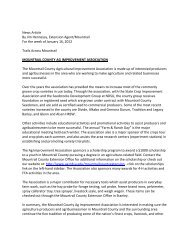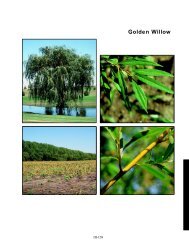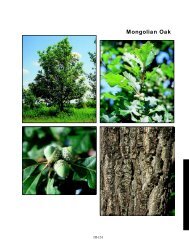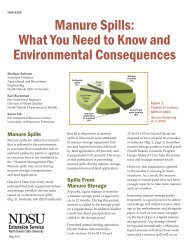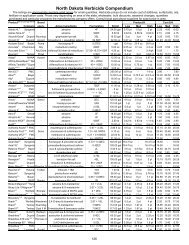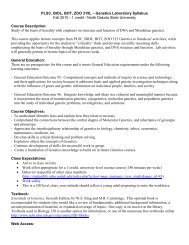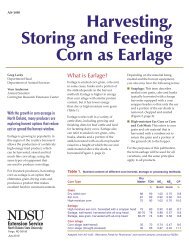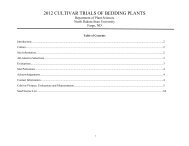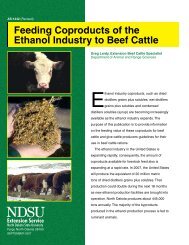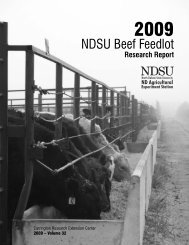Create successful ePaper yourself
Turn your PDF publications into a flip-book with our unique Google optimized e-Paper software.
<strong>Bio</strong> <strong>Strip</strong> <strong>Till</strong><br />
<strong>One</strong> <strong>Hit</strong>, <strong>One</strong> <strong>Miss</strong><br />
Kelly Cooper<br />
Farm Manager<br />
Conservation Cropping Systems Project<br />
Located 2<br />
miles south of<br />
Forman ND
What is CCSP<br />
• A soil conservation and water quality research and demonstration project<br />
using no-till and strip till farming methods.<br />
• Overseen by a local farmer board of directors from 6 SCD’s in Richland,<br />
Ransom, Sargent, Dickey in ND - Day and Marshall in SD.<br />
• Aggressively managed project of 200 large plots of 15 rotations.<br />
• Cooperative effort with Universities, NRCS, Local SCDs, conservation<br />
groups and agribusiness but is Independent.<br />
• 10 years of History.<br />
• Diverse combinations of rotations, cover crops, equipment, and<br />
philosophies.<br />
• Long and short term research and demonstration.
Crops at CCSP<br />
• 11 of our 15 rotations use spring or winter wheat.<br />
• 14 Use Corn, 12 use soybeans, 2 flax, 1 alfalfa.<br />
• NDSU has located their spring and winter wheat variety trials at our site.<br />
• Unique demonstrations<br />
– <strong>Bio</strong>-strip till in winter wheat stubble in preparation for corn.<br />
– Bird Repellant trial in winter wheat.<br />
– Growing winter wheat after early maturing soybeans.<br />
– Compost tea.<br />
– Winter wheat to recover prevent plant acres.<br />
– Radish trade name trial.<br />
– Cover crop demonstrations.<br />
– <strong>Strip</strong> till/variety trial.<br />
– Corn nematode seed treatment trial.<br />
• Typical demonstrations:<br />
– Varieties.<br />
– Seed Treatment.<br />
– Different drills used for seeding.<br />
– Herbicides.
Plot Map<br />
2012 new rotation<br />
Bulk 1switch<br />
1.2 Acres<br />
West plots 260 ft<br />
Bulk 2<br />
1.9 acres<br />
2012<br />
Jfx3 153 Dsw2 127 Ds2 105 Dc2 83 ip14 Cenex<br />
Jc3II Jc3I 154<br />
155<br />
ip8 Qc1l<br />
Jc1II<br />
106<br />
107<br />
ip5<br />
Ic1I<br />
Ifx1<br />
52<br />
53<br />
Fertilizer<br />
Plant<br />
Js3 156 Qc3II 130 ip7 Gs2ll 86 Iww1 54<br />
Jww3 157 Qc1 I 131 Gs2l 87 Isw1 55<br />
Fs3 158 Qc2 I 132 Qww1 110 Gc2lI 88 Is1 56<br />
Fc3 159 Qs3 I 133 Qsw1 111 Gc2I 89 Ic1II 57<br />
Qs2 II 160 Qs3II 134 Ms2II 112 Gsw2 90 Na1I 58<br />
Hc2_6 135 Mc2 II 113 Asw2 91 Fc2 59<br />
Ic3 I 203 Hc3_6 177 KHc2 136 Cww2 114 Aww2 92 Es2 60<br />
ip10.5<br />
Ifx3 204 KHc3 178 KHww2 137 Csw2 115 As2 93 Esw2 61<br />
Iww3 205 KHww3 179 Ds2 164 KHs2 138 Cs2 116 Ac2 94 Fs2 62<br />
Isw3 206 KHs3 180 Jfx1 165 OA2 139 Cc2 117 Nww1 32 Jc1 I 8<br />
Is3 207 OA3 181 Qww2 166 Hc2_8 140 Ic2I 118 ip6<br />
Nsw1 33 Js1 9<br />
Ic3 ll 208 Hc3_8 182 Na2 lI 167 Jfx2 141 Ifx2 119 Ns1 34 Jww1 10<br />
ip13.5<br />
c.4ac<br />
ip13<br />
Gs3 Il 183 Na2l 168 Jc2II 142 Iww2 120 Nc1 35 ip1<br />
Gs3 l 184 Nww2 169 Jc2I 143 Isw2 121<br />
Gc3 lI 185 Nsw2 170 Js2 144 Is2 122 Bww2 100 ip2<br />
Gc3I 186 Ns2 171 Jww2 145 Ic2II 123 Bsw2 101 ip4s Bww1 14<br />
Gsw3 187 Nc2 172 Qs2 lII 146 Qsw2 124 Bs2 102 Dsw1 39 Bsw1 15<br />
Es3 214 Aww3 188 Cww3 173 Qsw3 147 Qs1 III 125 Bc2 103 Hc1_6 71 Ds1 40 Bs1 16<br />
Esw3 215 Asw3 189 Csw3 174 Qc2lI 148<br />
Bulk 7<br />
KHc1 72 Dc1 41 Bc1 17<br />
Na3Il 216 As3 190 Cs3 175 Bww3 149 Bulk 6<br />
0.7 acres<br />
0.2 acres<br />
KHww1 73 KHs1 42 Aww1 18<br />
Na3 l 217 Ac3 191 Cc3 176 Bsw3 150 Hswc1 74 NDSU 43 Asw1 19<br />
Nww3 218 Gs1ll 192 ip11 Bs3 151 OA1 75 NDSU 44 As1 20<br />
Nsw3 219 Gc1lI 193 Bc3 152<br />
Bulk 8<br />
2.8 acres Hc1_8 76 NDSU 45 Ac1 21<br />
Ns3 220 Gc1l 194 ip9<br />
Mc1I 77 Qs1lI 46 Cww1 22<br />
Nc3 221 Gs1l 195 Lww1 78 Qs1l 47 Csw1 23<br />
Qc3I 222 ip12<br />
1st pass strip-tilled<br />
2nd not<br />
Fc1 79 Es1 48 Cs1 24<br />
Qs3lII Qww3<br />
223<br />
224 198<br />
Bulk 5<br />
1.8 acres<br />
3rd stiped<br />
Na1lI<br />
Qs2lI 80<br />
81<br />
Esw1<br />
Fs1<br />
49<br />
50<br />
Cc1 25a<br />
ip3<br />
Dsw3 225 Dsw3 199 Bulk 4<br />
Ac1 82 51 alfalfa va<br />
Gsw1 226 Ds3 200<br />
8.1 acres<br />
Qc3II 227 Dc3 201<br />
crop<br />
Bulk 3<br />
3.5 acres<br />
ip10
CCSP Rotation Key<br />
spring wheat/winter wheat/corn/soybeans - A<br />
spring wheat/winter wheat-st/corn/soybeans - B<br />
spring wheat/winter wheat-biost/corn/soybeans C<br />
spring wheat-st/corn/soybeans D<br />
spring wheat/soybeans E<br />
corn/soybeans-st F<br />
spring wheat-st/corn/soybeans/corn/soybeans G<br />
continues corn since 2006-st H6<br />
continues corn since 2008-st H8<br />
spring wheat/winter wheat/flax-st/corn-st/corn/soybeans I<br />
winter wheat/soybeans/corn-st/corn/flax J<br />
winter wheat-bio-strip-biost/corn/soybeans KH<br />
spring wheat/winter wheat/alfalfa/alfalfa/corn/soybeans N<br />
corn/cover crop O<br />
spr wht/win wht/soy/corn/soy/corn/soy Q<br />
note-st denotes strip till operation, cc-denotes cover crop
Radish and Peas<br />
The <strong>Bio</strong> <strong>Strip</strong> <strong>Till</strong> Dynamic Duo<br />
Today……
What is “Right” with this Picture??
What is “Wrong” with this Picture??
The Radish you Want!!
1 year old Radish
1 year old Radish
<strong>Bio</strong>-<strong>Strip</strong> Fall 2009<br />
Pea<br />
Radish
<strong>Bio</strong>-<strong>Strip</strong> Fall 2010
<strong>Bio</strong>-<strong>Strip</strong> till fall 2011
Materials and methods<br />
• 7200 John Deere planter with Kinze units.<br />
– 2009-used soybean plates.<br />
• Good for peas, high pop on radish.<br />
– 2010-11 used sorghum plates.<br />
• Good population control on radish, 60K/ acre or 1 ¼ lb.<br />
• Peas seeded at soybean population of 180K about ½ of<br />
normal 300,000 used for peas.<br />
– 2011 Also used 1590 John Deere, with some<br />
mods.
250<br />
200<br />
150<br />
100<br />
50<br />
0<br />
<strong>Bio</strong> <strong>Strip</strong> till was near top of Corn Yields in 2010<br />
Nc1<br />
Nc3<br />
Bc3<br />
Nc2<br />
KHc3<br />
KHc2<br />
Gc3lI<br />
Dc3<br />
Cc3<br />
Dc1<br />
Ic2I<br />
Bc1<br />
Jc3II<br />
Lc2lI<br />
Gc1l<br />
Dc2<br />
Bc2<br />
Fc3<br />
Jc1I
Yield Rotation<br />
bu/ac Rotation Yield<br />
Plots moisture Test Wgh Average<br />
1 212.2 14.9 58.3 Nc1 sw/ww/a/a/c/s<br />
4 198.0 15.9 60.0 Nc2 206.9 No strip till<br />
2 210.5 15.7 58.2 Nc3<br />
2010 Corn Yields<br />
168.4 16.6 57.8 Bc1 sw/ww/c/s - shank drill<br />
162.1 17.4 57.5 Bc2 178.4 <strong>Strip</strong> tilled<br />
3 204.6 15.3 58.4 Bc3<br />
173.9 16.0 56.9 Dc1 sw/c/s<br />
162.2 16.2 57.6 Dc2 171.6 <strong>Strip</strong> tilled<br />
178.7 15.6 57.1 Dc3<br />
138.4 16.0 51.7 KHc1 ww-cc/corn/s<br />
5 182.1 18.0 56.8 KHc2 170.1 <strong>Bio</strong>-<strong>Strip</strong> till<br />
6 189.7 16.8 57.9 KHc3<br />
169.1 20.4 54.3 Lus1 I 169.1 cc/corn<br />
Rotation<br />
Key
180<br />
170<br />
160<br />
150<br />
140<br />
130<br />
120<br />
163<br />
2010 <strong>Strip</strong> <strong>Till</strong><br />
170<br />
123<br />
Wheat <strong>Strip</strong>ped <strong>Bio</strong> <strong>Strip</strong> Wheat Not <strong>Strip</strong>ped
2011<br />
• Hail and wind wrecked havoc on the plots,<br />
but……<br />
– Things did not look good right from the start.<br />
– Poor germination, seed rot, and slow growth.<br />
• Why??<br />
– My best guess.<br />
• The “wrong” radish left behind either organisms or<br />
chemistry that was not friendly to the sprouting corn.
200.0<br />
180.0<br />
160.0<br />
140.0<br />
120.0<br />
100.0<br />
80.0<br />
60.0<br />
40.0<br />
20.0<br />
0.0<br />
26.8<br />
Dekalb<br />
43-27<br />
165.0<br />
Previous Crop: Soybeans<br />
<strong>Strip</strong> <strong>Till</strong>/Variety Trial 2009 CCSP<br />
191.8<br />
7.6<br />
Croplan<br />
2924<br />
180.6<br />
188.2<br />
32.1<br />
Pioneerr<br />
38M60<br />
151.8<br />
183.9<br />
17.7 24.2<br />
Croplan<br />
3114<br />
165.5<br />
183.2<br />
Pioneer<br />
9494XR<br />
147.0<br />
171.2<br />
21.7<br />
Average<br />
162.0<br />
183.7<br />
Yield <strong>Strip</strong> till<br />
Yield No-<strong>Strip</strong><br />
<strong>Strip</strong> till Difference
180.0<br />
160.0<br />
140.0<br />
120.0<br />
100.0<br />
80.0<br />
60.0<br />
40.0<br />
20.0<br />
0.0<br />
-20.0<br />
3.0<br />
158.7<br />
161.7<br />
1.7<br />
158.7<br />
<strong>Strip</strong> <strong>Till</strong>/Variety Trial 2010 CCSP<br />
7.2<br />
Previous Crop: Soybeans<br />
160.4 159.3 159.1<br />
152.1<br />
19.1<br />
13.9<br />
154.7<br />
140.1 140.8 148.5<br />
4.4<br />
152.9<br />
149.5<br />
-5.1<br />
144.4<br />
131.2<br />
127.8<br />
3.3 5.9<br />
153.0<br />
147.0<br />
Yield <strong>Strip</strong> till<br />
Yield No-<strong>Strip</strong><br />
<strong>Strip</strong> till Difference
90.0<br />
80.0<br />
70.0<br />
60.0<br />
50.0<br />
40.0<br />
30.0<br />
20.0<br />
10.0<br />
0.0<br />
12.0<br />
Croplan<br />
229VT3<br />
72.3<br />
Previous Crop: Soybeans<br />
<strong>Strip</strong> <strong>Till</strong>/Variety Trial 2011 CCSP<br />
84.3<br />
-2.2<br />
Croplan<br />
1829VT2P<br />
82.5<br />
80.3<br />
3.6<br />
Pioneer<br />
39V07<br />
69.9<br />
73.5<br />
14.4<br />
Pioneer<br />
39D97<br />
52.6<br />
67.0<br />
7.0<br />
averages<br />
69.3<br />
76.3<br />
Yield <strong>Strip</strong> till<br />
No strip-till<br />
<strong>Strip</strong> till Difference
Why would bio <strong>Strip</strong> till work?
2010 Planting Corn on <strong>Strip</strong> till
<strong>Strip</strong> till water erosion
Why would bio <strong>Strip</strong> till work?<br />
Pros:<br />
Open up channels for fast root proliferation.<br />
Provide organic matter for symbiotic organisms to become established on and<br />
increase population.<br />
Separation of legumes and fertilizer.<br />
Concentration of low C/N material for rapid decomposition of straw.<br />
Cons:<br />
Alleopathy.<br />
Cost.<br />
Special equipment may be required.
Innovations<br />
• What other species would work?<br />
– Flax-intense colonizer of micorrhiza.<br />
– Suggestions?<br />
• Other Considerations.<br />
– Could use system for soybeans.<br />
– Select bio-strip planting for soybean cyst nematode<br />
suppression.<br />
– Radish and rye effective for cyst egg reduction.<br />
– Both can induce hatching in the fall, 80-90% reduction<br />
in parasitic nematodes. (Ohio State Fact sheet SAG-15-11)
Innovations<br />
• What would happen if:<br />
– You did conventional strip till in wheat with<br />
fertilizer right after harvest, then planted biostrip?<br />
• Stabilize nitrogen.<br />
• Enhance growth of radish.<br />
• By keeping nitrogen away from pea, maintain rhizobia<br />
nitrogen production.
Fertilizing Cover Crops<br />
Yes<br />
No Nitrogen
Considerations of the <strong>Bio</strong> Chemical Factory<br />
Egyptian Journal of Horticulture (1989)<br />
Volume: 16, Issue: 2, Pages: 165-172<br />
Find this paper at:<br />
openurl.ac.ukWorldCat®Google ScholarEdit library access links Abstract<br />
Root exudates of the crops of family cruciferae, i.e. cabbage, radish and cauliflower<br />
decreased the percentage of tomato seed germination. The highest value of tomato seed<br />
germination was reported with the control plants (92.2%). On the other hand, the lowest<br />
one was occurred with radish exudates (85.6%). Also, root exudates of these crops showed<br />
a significant depressing effect on germination rate index (GRI). The germination rate index<br />
(GRI) of tomato seeds can be arranged in the following descending order, cabbage (0.55) gt<br />
cauliflower (0.53) gt Radish (0.51). The averages of tomato fresh seedling weight decreased<br />
significantly when tomato seeds were treated with the different crops of family cruciferae<br />
in comparison with that of the control. The growth values of seedlings 45 days old was<br />
decreased significantly when tomato seeds were treated with cabbage, cauliflower and<br />
radish root exudates.
Considerations of <strong>Bio</strong> <strong>Till</strong>age<br />
From an article in “<strong>Strip</strong> till Farmer”<br />
“Including a few pounds of oilseed radish with legumes can<br />
substantially improve the benefits of cover crops, says Ohio State<br />
University cover crops researcher Rafiq Islam.<br />
"The roots of oilseed radish can reach deep into the soil — as much as<br />
30 inches — breaking up compacted soils and acting as natural striptill,"<br />
Islam says. "The roots are supporting microbial diversity, facilitating<br />
drainage and improving soil structure.<br />
"If you grow a legume cover crop along with oilseed radish, you don't<br />
need to subsoil or deep plow. The crops work together as a natural<br />
biological plow.“”
Fall 2011
Spring 2012
Next field day July 12, 2012
David, Wally, and Turk
Thank You!
Questions????




